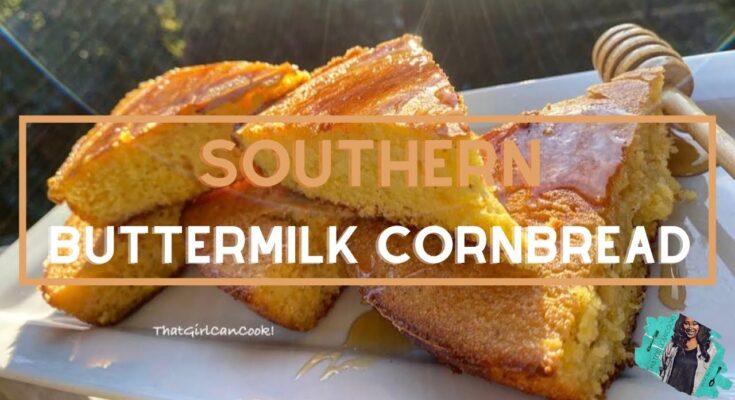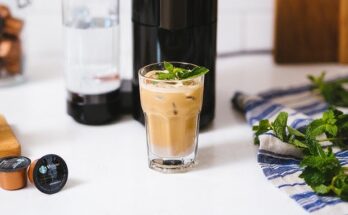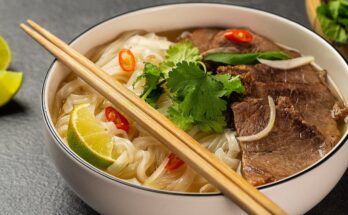Buttermilk Cornbread Recipe: Buttermilk cornbread is a Southern classic—warm, crumbly, and slightly tangy from the buttermilk. It’s comfort food at its finest, the kind of dish that brings back memories of Sunday dinners, barbecues, and holiday feasts. Unlike sweet Northern-style cornbread, Southern buttermilk cornbread is typically more savory, with a rich golden crust and a tender interior. Whether served with a slather of butter or paired with chili or greens, this dish never fails to hit the spot.
Cornbread has deep roots in American history, particularly in Native American and Southern cuisines. The traditional recipe has evolved over time, but buttermilk remains a staple for many, thanks to its ability to add both moisture and flavor. The result? A beautifully balanced bread that’s rustic, hearty, and incredibly easy to make.
Why Use Buttermilk?
Buttermilk isn’t just there for flavor (though it does bring a slight tang that makes cornbread irresistible). Its acidity reacts with baking soda or baking powder to create a light, fluffy texture. This reaction is what gives buttermilk cornbread that perfect rise without being dense or dry.
Also, it helps keep the bread moist. Let’s face it—nobody likes dry cornbread. Using buttermilk ensures that the end result is soft on the inside with just enough crumb to make it hearty. Plus, it adds that old-fashioned depth of flavor you can’t quite replicate with milk or cream.
Ingredients You’ll Need
Essential Ingredients Breakdown
To make a classic buttermilk cornbread, you’ll need a short list of pantry staples. Here’s what you’ll need for a traditional recipe:
- 1 cup cornmeal (yellow, finely ground for a smoother texture)
- 1 cup all-purpose flour
- 1 tablespoon baking powder
- 1/2 teaspoon baking soda
- 1/2 teaspoon salt
- 2 tablespoons sugar (optional for a touch of sweetness)
- 2 large eggs
- 1 1/2 cups buttermilk
- 1/4 cup melted butter or oil (plus more for greasing)
These ingredients come together to create the perfect balance of flavor, texture, and moisture. The cornmeal brings that gritty, rustic feel, while the flour lightens things up for a more tender crumb.
Optional Add-ins and Flavor Twists
Want to take your cornbread to the next level? Here are some tasty mix-ins:
- Shredded cheddar cheese – for a cheesy, savory twist
- Diced jalapeños – for a spicy kick
- Corn kernels – adds texture and a little sweetness
- Chopped scallions or chives – fresh flavor and color
- Honey drizzle or maple syrup – for sweet cornbread lovers
These additions can help you tailor the dish to your meal or your mood. Whether you’re going for spicy, cheesy, or sweet, cornbread is super adaptable.
Tools and Equipment Required
Kitchen Tools You Should Have
Before you dive into baking, make sure you’ve got the right tools:
- Mixing bowls (at least two)
- Measuring cups and spoons
- Whisk or wooden spoon
- Rubber spatula
- Oven mitts
These are your basics for any baking task, but for cornbread, it’s especially important to use accurate measurements and good mixing techniques.
Best Type of Skillet or Baking Dish
Want that crispy, golden crust that people rave about? Use a cast iron skillet. It retains heat like a champ and creates the perfect edge. If you don’t have one, a glass or metal baking dish will still do the job—just grease it well and preheat it before pouring in the batter.
A well-seasoned cast iron skillet, though, is cornbread’s best friend. It creates that Southern-style crust that crunches perfectly with each bite.
How to Make Buttermilk Cornbread – Step-by-Step Instructions
Step 1: Preheat and Prepare
Start by preheating your oven to 425°F (220°C). If you’re using a cast iron skillet, pop it into the oven while it preheats. A hot skillet gives the batter an instant sizzle when poured in, which leads to that amazing crust we all love.
Also, this is a good time to grease your pan—whether you’re using butter, oil, or even a little bacon grease for that extra Southern flair.
Step 2: Mixing the Dry Ingredients
In a large mixing bowl, whisk together:
- 1 cup cornmeal
- 1 cup all-purpose flour
- 1 tbsp baking powder
- 1/2 tsp baking soda
- 1/2 tsp salt
- 2 tbsp sugar (if using)
Whisking helps to aerate the dry ingredients, ensuring your cornbread rises evenly and stays fluffy.
Step 3: Combining Wet Ingredients
In a separate bowl, beat the two eggs lightly, then add:
- 1 1/2 cups buttermilk
- 1/4 cup melted butter or oil
Whisk everything until combined. The mixture should be smooth but not frothy.
Step 4: Mix Wet and Dry – But Don’t Overdo It!
Pour the wet mixture into the bowl with the dry ingredients. Using a rubber spatula or wooden spoon, gently fold the two together just until combined. A few lumps are fine! Overmixing will make the cornbread tough and chewy instead of soft and tender.
If you’re using any add-ins like cheese or jalapeños, now’s the time to fold them in.
Step 5: Bake to Golden Perfection
Carefully take your hot skillet or baking dish from the oven. Pour the batter in—it should sizzle a bit if the skillet is hot enough. Spread it evenly with a spatula if needed.
Bake for 20–25 minutes, or until the top is golden and a toothpick inserted in the center comes out clean. Let it cool for about 10 minutes before slicing.
Tips for the Best Buttermilk Cornbread
How to Get That Perfect Crust
Let’s be honest—half the magic of great cornbread is in the crust. That golden, slightly crispy edge adds so much character to every bite. So, how do you get it just right? It starts with the skillet. A cast iron skillet, preheated with a little butter or oil, creates the perfect base for a crunchy crust. When your batter hits that hot surface, it starts cooking instantly, forming a beautiful crust before it even enters the oven.
Another trick? Don’t skip the preheat stage. This might seem like an extra step, but trust me—it’s what separates decent cornbread from restaurant-quality results. Also, try using bacon grease instead of butter in your skillet for a smoky, Southern flair that deepens the flavor and enhances the crust even more.
Lastly, don’t overcrowd the batter. Pour it evenly and avoid overfilling the pan. This helps it cook evenly and crust up beautifully around the edges. A thin layer of batter actually leads to a more even crust-to-crumb ratio.
Keeping It Moist and Fluffy
We’ve all been there—taking a bite of what looks like a golden slice of cornbread only to discover it’s dry, dense, and crumbly. The key to avoiding that? Moisture and balance.
Buttermilk does most of the heavy lifting here, but make sure you’re using the right ratio of liquid to dry ingredients. Adding too much flour or not enough fat can leave your cornbread dry. Using melted butter or oil keeps the crumb tender while also locking in moisture.
Also, don’t overbake. Cornbread keeps cooking slightly after it’s taken out of the oven, so if the edges are pulling away from the skillet and the center springs back lightly to the touch, it’s done. Overbaking is the quickest route to dried-out slices.
If you’re making your cornbread ahead of time, brush the top with a bit of melted butter right after it comes out of the oven. It adds richness and helps seal in moisture, especially if you’re storing it overnight.
Serving Suggestions
What to Serve with Buttermilk Cornbread
Cornbread is one of the most versatile side dishes out there. It goes with just about anything and can be dressed up or down depending on the occasion.
Here are some classic pairings:
- Chili – A hearty bowl of beef or vegetarian chili with a slice of cornbread is a match made in heaven.
- Fried Chicken – For the ultimate Southern plate, serve alongside crispy fried chicken and collard greens.
- BBQ – Pulled pork, ribs, or brisket practically beg for cornbread on the side.
- Soups and Stews – Cornbread soaks up broth beautifully, making it a great partner for anything from gumbo to chicken stew.
- Salads – Crumbled over a fresh garden salad or served with a zesty vinaigrette on the side.
You can also serve it as a standalone snack or appetizer with a bit of butter or honey.
Sweet vs. Savory Toppings
Cornbread doesn’t need much to be delicious—but toppings can take it to a whole new level.
Sweet Options:
- Honey butter
- Maple syrup
- Fruit preserves or jam
- Cinnamon sugar
Savory Options:
- Herb-infused butter (like rosemary or thyme)
- Cream cheese with chives
- Pimento cheese spread
- Spicy jalapeño jelly
Whether you lean sweet or savory, there’s no wrong way to enjoy a warm slice. Try different combinations and find your perfect match.
Storing and Reheating Leftovers
How to Store Cornbread Properly
Got leftovers? No worries—cornbread stores surprisingly well if done right. First things first: let it cool completely before you stash it away. Trapping heat can cause moisture buildup, which leads to soggy bread and spoilage.
Here are your storage options:
- Room Temperature: Wrap tightly in plastic wrap or place in an airtight container. Will stay fresh for up to 2 days.
- Refrigerator: If you want to keep it longer, the fridge is your friend. Store in a sealed container for up to 1 week.
- Freezer: Yes, you can freeze cornbread! Wrap slices individually in foil or freezer bags. It’ll keep for up to 3 months. When you’re ready to enjoy it, thaw at room temp or microwave briefly.
Reheating Without Drying It Out
Reheating cornbread can be tricky—it dries out fast if you’re not careful. Here’s how to warm it up while keeping that soft interior:
- Microwave: Wrap a slice in a damp paper towel and heat in 15-second intervals.
- Oven: Preheat to 300°F, wrap slices in foil, and warm for 10-15 minutes.
- Skillet: Add a tiny bit of butter to a pan, heat your slice low and slow—crisps the bottom while warming it through.
A quick brush of butter after reheating brings back that fresh-baked texture and flavor like magic.
FAQs about Buttermilk Cornbread Recipe
Q1: Can I use regular milk instead of buttermilk?
Technically yes, but it won’t be the same. Buttermilk adds that tangy kick and keeps the cornbread super moist. No buttermilk? Mix 1 cup of milk with 1 tablespoon of lemon juice or vinegar—let it sit for 5 minutes. Boom, DIY buttermilk.
Q2: What kind of cornmeal should I use?
Stick with yellow cornmeal for that classic flavor and color. Fine or medium grind works best—steer clear of coarse grind unless you want a gritty bite.
Q3: Can I make it without sugar?
Yep! Traditional Southern cornbread is usually savory. If you’re going for the sweet, cake-like version (hello, Northern style), keep the sugar in. Your kitchen, your rules.
Q4: How do I get crispy edges on my cornbread?
Use a hot cast iron skillet. Heat it in the oven with a bit of oil before pouring in the batter. It’ll sizzle like a summer barbecue and give you those golden, crunchy edges.
Q5: How should I store leftover cornbread?
Wrap it tight or toss it in an airtight container. It stays fresh for 2–3 days at room temp, or up to a week in the fridge. Reheat in the oven or microwave with a damp paper towel to keep it from drying out.
Q6: Can I freeze buttermilk cornbread?
Absolutely. Let it cool, wrap slices individually, and freeze. When ready to eat, thaw and reheat—still fluffy, still delicious.
Conclusion
Buttermilk cornbread is more than just a side dish—it’s a warm, nostalgic experience baked into a cast iron skillet. From its crispy crust to its moist, tender center, every bite feels like home. Whether you’re serving it with chili, slathering it with honey butter, or enjoying it plain and simple, it’s the kind of food that makes everyone at the table happy.
With just a few pantry staples and these easy-to-follow steps, you can whip up a batch that’s perfect every time. Don’t be afraid to experiment with add-ins, serve it with bold dishes, or store leftovers for later cravings. Cornbread’s got your back.



